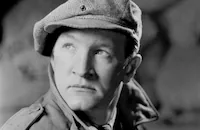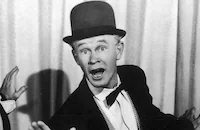A Dangerous Adventure
Cast & Crew
D. Ross Lederman
Don Terry
Rosalind Keith
Nana Bryant
John Gallaudet
Frank C. Wilson
Film Details
Technical Specs

Synopsis
At the Gale Steel and Iron Works in Galesburg, Tim Sawyer, known as "Shoulders," is the tough production manager frustrated by the company's refusal to spend money for repairs. The plant is part of the estate of the late David Gale, and much to everyone's surprise the heir is his daughter, debutante Linda Gale. Marie Wall, Linda's aunt, serves as Linda's proctor. During Linda's tour of the plant, some gears break, nearly killing Dutch Fulmer, a foreman who is wrongfully blamed for the accident. Mr. Spencer Allen, the office manager who wants the plant to go bankrupt, convinces Linda to give the overworked men a holiday. However, they resent the loss of pay, and know it is repairs that are truly needed. Tim only continues to work at Gale in order to teach Linda the business he has worked at since he was thirteen. After rescuing a man from being boiled by a broken furnace, Tim quits, leaving behind Blister, a lad he was trying to educate. Allen orders George Billings to substitute high-carbon, poor quality steel on the Harmon order, the last major company still using the Gale Works. As a result, Harmon's skyscraper frame collapses, and Linda and her company are sued for $1,000,000. Allen tries to blame the incident on Tim, but Harmon's representative refuses to believe it was Tim's fault. Linda asks Tim for his help, and he discovers that the steel made for Harmon, substituted by Billings, is still at the plant. Tim has Linda summon Allen and Billings, and together with the help of Dutch and Blister beats a confession out of them. Despite the fact that he does not want to work for a woman, Linda asks Tim to stay on as general manager of the plant.

Director

D. Ross Lederman
Cast
Don Terry
Rosalind Keith

Nana Bryant

John Gallaudet
Frank C. Wilson
Marc Lawrence

Russell Hicks

Joseph Sawyer
Richard Curtis

Billy Benedict
George Pearce
Milton Owen
Lenita Lane
Walter Soderling
Roger Gray
Johnny Tyrrell
Lee Prather
Beatrice Blinn
Raymond Turner
Edmund Cobb
Billy Arnold
Joe Bordeaux
Bud Geary
Jack Cheatham
George Mcgrill
Crew
Irving Briskin
Harry Cohn
Owen Francis
Owen Francis
Gene Havlick
Kalloch
Benjamin Kline
Wallace Macdonald
William Mull
John Rathmell
Michael Simmons
Morris Stoloff

Film Details
Technical Specs

Articles
Marc Lawrence (1910-2005)
Born Max Goldsmith on February 17, 1910, in the Bronx, Lawrence had his heart set on a career in drama right out of high school. He enrolled at City College of New York to study theatre, and in 1930, he worked under famed stage actress Eva Le Gallienne. Anxious for a career in movies, Lawrence moved to Hollywood in 1932 and found work immediately as a contract player with Warner Bros. (an ideal studio for the actor since they specialized in crime dramas). He was cast as a heavy in his first film, If I Had a Million (1932). Although his first few parts were uncredited, Lawrence's roles grew more prominent: a sinister henchman in the Paul Muni vehicle in Dr. Socrates (1935); a conniving convict aiding Pat O'Brien in San Quentin (1937); a menacing thug stalking Dorothy Lamour in Johnny Apollo (1940); the shrewdly observant chauffeur in Alan Ladd's breakthrough hit This Gun For Hire (1942); and one of his most memorable roles as Ziggy, a fedora wearing mobster in the Bogart-Bacall noir classic Key Largo (1948).
Lawrence, when given the opportunity, could play against type: as the prosecuting attorney challenging Tyrone Power in Brigham Young (1940); a noble aristocrat in the Greer Garson-Walter Pidgeon period opus Blossoms in the Dust; and most impressively, as a deaf mute simpleton in the rustic drama The Shepherd of the Hills (both 1941). Better still was Lawrence's skill at comedy, where his deadpan toughness worked terrifically as a straight man against the likes of Joe E. Brown in Beware Spooks (1939); Abbott and Costello in Hit the Ice (1943); Penny Singleton in Life with Blondie (1945); and Bob Hope in My Favorite Spy (1951).
After that, Lawrence's career took a turn downward spin when he was labeled a communist sympathizer during the Hollywood witch hunts of the early '50s. He was exiled in Europe for a spell (1951-59), and when he came back, the film industry turned a blind eye to him, but television overcompensated for that. Here he played effective villains (what else?) in a series of crime caper programs: Peter Gunn, Johnny Staccato, The Untouchables, Richard Diamond, Private Detective; and eventually made a welcome return to the big screen as a returning exiled gangster in William Asher's underrated mob thriller Johnny Cool (1963).
It wasn't long before Lawrence found himself back in the fray playing in some big box-office hits over the next two decades: Diamonds Are Forever (1971), The Man with the Golden Gun (1974), Marathon Man (1976), Foul Play (1978); and The Big Easy (1987). Sure he was cast as a gangster, but nobody could play a rough and tumble mob boss with more style or conviction.
Interestingly, one of his finest performances in recent years was in television, as a severely ill old man unwilling to accept his fate in a fourth season episode of ER (1997-98). His last screen role was just two years ago, as a nimble minded VP in Looney Tunes: Back in Action (2003).
In 1991, Lawrence published a memoir about his venerable career, Long Time No See: Confessions of a Hollywood Gangster that received much critical acclaim. He has also developed a cult following due to his appearances in such offbeat items as From Dusk to Dawn and Pigs aka Daddy's Deadly Darling, the 1972 horror film he directed and starred in with his daughter Toni. He is survived by his wife, Alicia; two children from a previous marriage, Toni and Michael; and a stepdaughter Marina.
by Michael T. Toole

Marc Lawrence (1910-2005)
Quotes
Trivia
Notes
The working title of this film was White Heat. According to the Variety review, Don Terry had made a few silent pictures, then went to the stage before returning to motion pictures in 1937.














